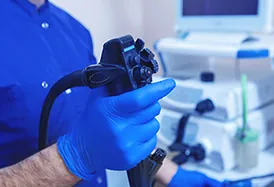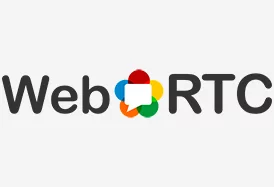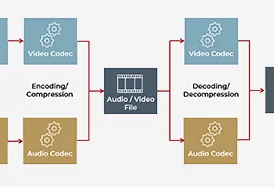![]() To successfully create a digital video product design, detailed knowledge of multiplexing, synchronization, and communications protocols are required. Having worked in video product engineering since the earliest days of the digital revolution, we possess a unique specialty in sophisticated video streaming system design. Combining inexpensive yet powerful processors with sophisticated compression algorithms makes digital video affordable in a wide range of applications.
To successfully create a digital video product design, detailed knowledge of multiplexing, synchronization, and communications protocols are required. Having worked in video product engineering since the earliest days of the digital revolution, we possess a unique specialty in sophisticated video streaming system design. Combining inexpensive yet powerful processors with sophisticated compression algorithms makes digital video affordable in a wide range of applications.
Typical video product development leverages an over the top (OTT) solution or mobile app, involving the streaming of both live and stored content using an adaptive bitrate protocol and digital rights management to protect the content. Our deep experience utilizing the appropriate mix of codecs, streaming protocols, DRM, and encryption standards achieves maximum performance under constrained hardware or networking conditions. Cardinal Peak has guided dozens of household names to successful and profitable product launches.
Video Product Engineering Case Studies
As one of the top streaming video product design firms, Cardinal Peak supports innovative streaming video designs including the projects below.

Remote Surveillance Camera System Development to Modernize Investigations

Leveraging Video & GenAI for Enhanced Visual Workflow Efficiency

Advancing Medical Diagnoses with Enhanced Endoscopy Machine Video Capabilities
Video Product Development Services FAQs
What is Video Streaming System Design?
Video streaming system design focuses on the processing and delivery of many different video streams. You can think of these systems as fitting into three broad categories: 1) few streams to many viewers (like TV), 2) a couple of streams to a couple of viewers (like home security), or 3) many streams to a few viewers (like a security system for a business). Each of these classes of solutions are optimized to minimize cost while providing the best end-user experience. As video streams are large, they can consume significant bandwidth and memory if stored, so the design is often optimized for bandwidth and memory. Depending on the nature of the video stream, latency might be a big concern such as a conferencing system or targeting system. In those cases, the video streaming system design will be optimized for latency too. Cardinal Peak has been developing streaming video solutions since its inception. If you have a video need, please contact us for an initial consultation.
What Does Streaming Video Product Design Entail?
Streaming video products are connected devices that can stream their video to other locations. For example, look at a fairly typical application of a video camera as part of a smart home monitoring system, whether to keep an eye on the dog from work or water leaks while on vacation. First, the camera module has the sensor, memory and a radio for connectivity. Next, there is a cloud application for the camera to send its data. Finally, a smartphone app and/or a browser-based viewer controls the camera and lets you view live and stored video. As you dig into this seemingly simple application you find that you don’t want to send all the data to the cloud as the costs would be too expensive, especially considering that 99.9% of the video will never be watched. On the flip side, you want snappy response in the app, so you don’t want to add the delay of establishing a link directly to the camera whenever someone wants to view the video (especially if this is a battery powered device that might sleep to save power). When we faced this exact set of requirements, we put enough memory on the camera to store a few days of video before overwriting old video. Then when the algorithms on the device recognize activity of interest, the camera automatically uploads a short clip to the cloud and alerts the user through the smartphone app. The end-user can instantly play any clips from the cloud and if one is of interest they can continue watching from that point. What the user does not know is that only a short clip is on the cloud and by the time they reach the end the clip, the video is streaming from the camera’s memory. This provides snappy behavior while minimizing cloud costs. In summary, a streaming video product design entails the physical product along with a cloud application and frequently end-user command and control applications. While every product is a little different, with a streaming device you need to think about where the data is streaming to and what processing needs to happen there.
How Long Does Video Product Engineering Take?
How long it will take to design, test and get a video product into production depends on the design complexity. We start by asking if this a green or brown field development, meaning is this a totally new product or enhancement of an existing product. Generally, there is a lot of reuse for a second-generation product and since the product has been in the market, there is a lot of customer feedback that guides the requirements. Developing new hardware can impact on the overall schedule too. While we generally develop hardware and software in parallel, there is a limit to how much hardware development can be accelerated because of the physical manufacturing steps. Other factors in the overall schedule include required certifications, such as FCC. While every project is unique, our typical product development schedules are 6 to 9 months. Contact us and we can estimate the schedule for your product.
Video Product Engineering Related Articles

The H.264 Sequence Parameter Set

WebRTC Tutorial for Interactive Video Streaming

Streaming Media & Video Encoding Formats and Trade-Offs
If you’re working with streaming media, it’s important to understand how different encoding formats and codecs are used to package media so that you can make informed decisions.
If you’re working with streaming media, it’s important to understand how different encoding formats and codecs are used to package media so that you can make informed decisions.
